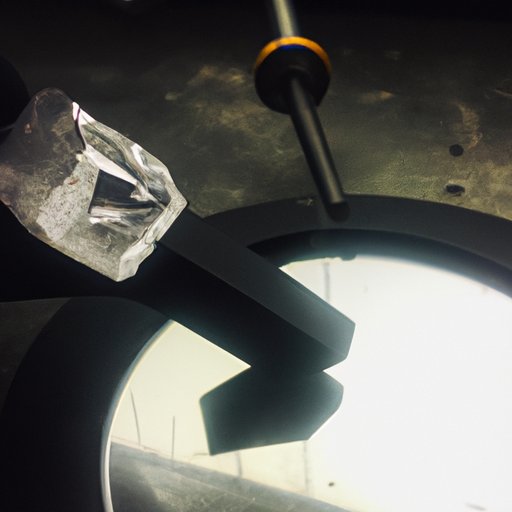Introduction
Diamonds have long been valued for their beauty and rarity. Though many people are familiar with the characteristics of a diamond, few understand the geology behind its formation. This article will explore the science of diamond formation, examining the conditions necessary for its creation and the geological processes that lead to its existence.

Exploring the Geology of Diamond Formation
In order to understand diamond formation, it is essential to know what diamonds are made of and where they can be found. Diamonds are crystalline structures composed of pure carbon atoms arranged in a tetrahedral lattice. As the hardest natural material known to man, diamonds are extremely durable and resistant to wear and tear. They come in a variety of colors, depending on their origin and chemical composition. Diamonds can be found in nature in kimberlite pipes, sedimentary rocks, and metamorphic rocks.

Understanding the Conditions Necessary for Diamond Formation
The creation of a diamond requires specific conditions in order to occur. Carbon is essential to diamond formation as it forms the basis of the diamond structure. Pressure and temperature also play a major role in diamond formation as these two forces are necessary to bring the carbon atoms together and form a diamond.
Examining How Diamonds are Formed from Carbon
Diamonds are created when carbon molecules are subjected to extreme pressure and heat. The process of crystallization involves the rearrangement of carbon atoms into a diamond lattice structure. This process is known as the “diamond cycle” and is the same process used by scientists in laboratories to create synthetic diamonds.

Analyzing the Process of Diamond Creation in Nature
Diamonds are formed in nature through a combination of geological processes. These include mantle convection, which is the movement of molten rock deep within the Earth, and subduction, which is the process by which one tectonic plate slides beneath another. These processes cause extreme temperatures and pressures to be exerted on the underlying carbon, resulting in diamond formation.
Investigating How Pressure and Temperature Impact Diamond Formation
The pressure and temperature necessary for diamond formation can vary greatly depending on the type of diamond being formed. Generally, diamonds require temperatures between 900 and 1,300 degrees Celsius (1,650 and 2,370 degrees Fahrenheit) and pressures between 45 and 60 kilobars. The higher the pressure and temperature, the faster the diamond crystals can form.
Comparing Diamond Formation Above and Below Earth’s Surface
Diamonds can be formed both above and below the Earth’s surface. Those formed below the surface are known as primary deposits and those formed above the surface are known as secondary deposits. Primary deposits are typically older and more valuable than secondary deposits. The differences between the two types of deposits have implications for diamond mining and cutting.
Describing How Diamonds are Mined and Cut
Diamonds are mined using a variety of methods, including open-pit mining, underground mining, and alluvial mining. After the diamonds are extracted, they are cut and polished to enhance their clarity and brilliance. This process is highly specialized and requires the expertise of skilled craftsmen.
Conclusion
In conclusion, diamonds are formed from carbon molecules under extreme pressure and temperature. The geological processes of mantle convection and subduction create the conditions necessary for diamond formation. Understanding the process of diamond formation is important for mining, cutting, and polishing diamonds. With this knowledge, people can better appreciate the beauty and rarity of diamonds.


